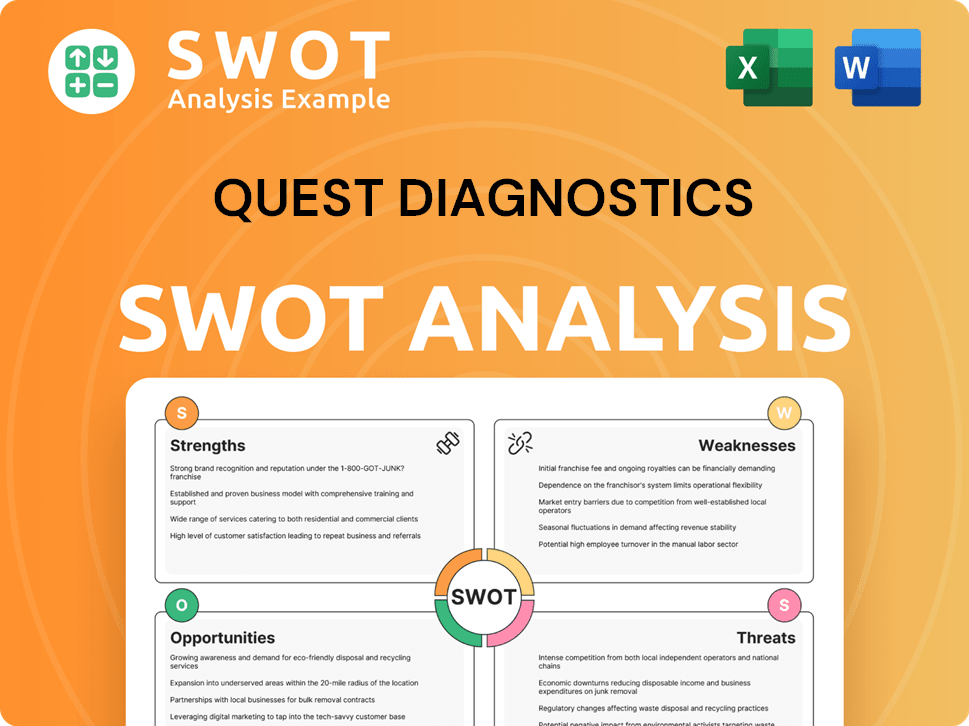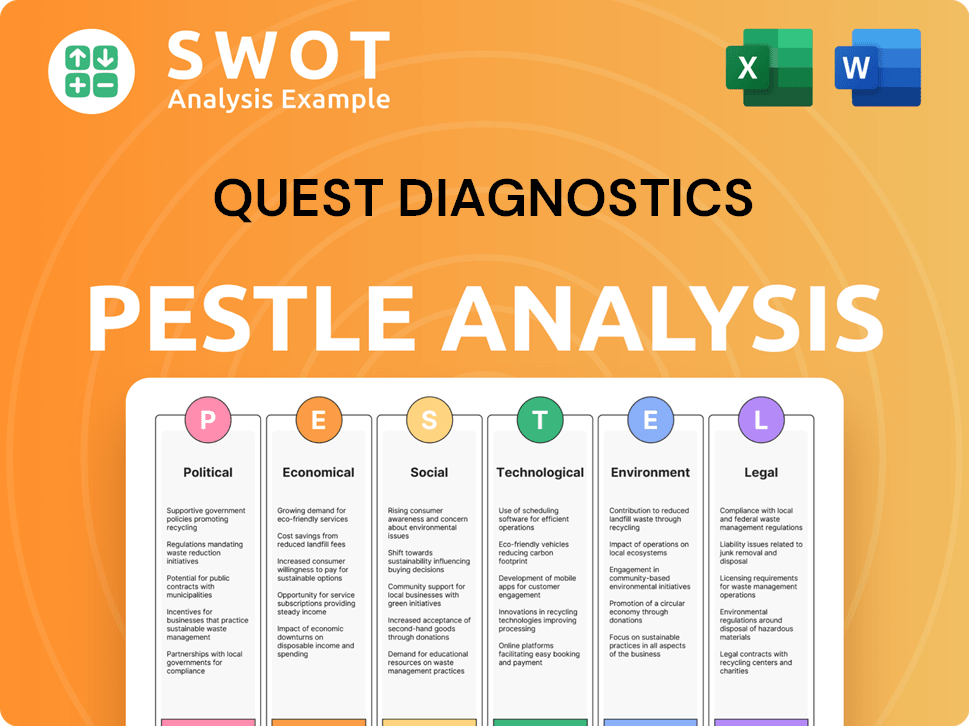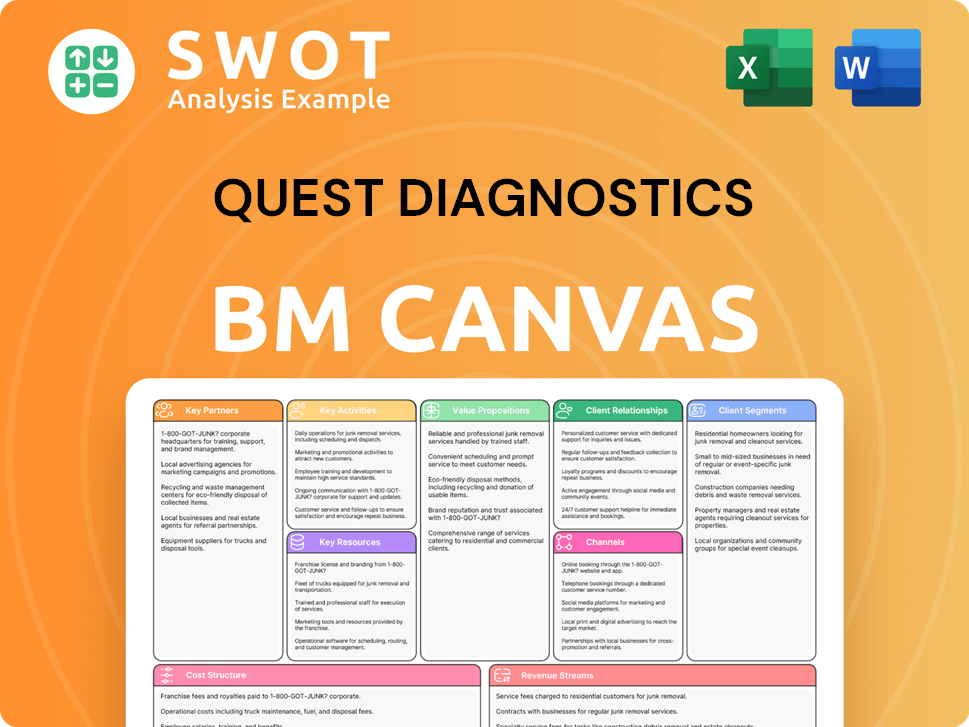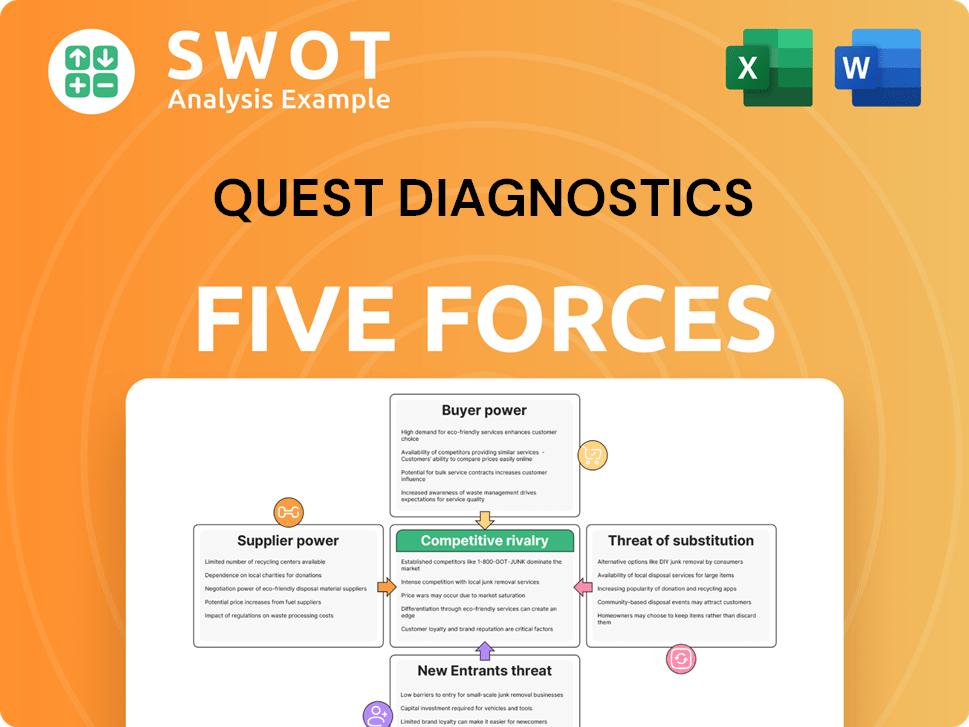Quest Diagnostics Bundle
How Does Quest Diagnostics Dominate the Diagnostic Testing Arena?
Quest Diagnostics, a titan in the diagnostic information services sector, plays a pivotal role in modern healthcare. Its journey, from a small lab to a global leader, highlights the company's resilience and strategic acumen. Understanding Quest Diagnostics' position requires a deep dive into its competitive environment and the factors driving its success.

From its inception in 1967, Quest Diagnostics has evolved dramatically, now serving a vast patient base and consistently demonstrating strong financial performance. The company's Quest Diagnostics SWOT Analysis reveals key insights into its strengths, weaknesses, opportunities, and threats within the dynamic diagnostic testing market. A thorough market analysis, including examining Quest Diagnostics' competitors and industry trends, is crucial for investors and strategists alike. This analysis will explore Quest Diagnostics' competitive advantages and provide a comprehensive view of its future outlook.
Where Does Quest Diagnostics’ Stand in the Current Market?
Quest Diagnostics holds a leading market position in the diagnostic testing industry, primarily due to its extensive network and broad service offerings. As of Q1 2025, the company secured a market share of approximately 44.22% based on total revenue, indicating its significant presence in the clinical diagnostics sector. This strong market position is a key element in understanding the overall competitive landscape.
The company operates a vast network of roughly 2,300 patient service centers across the United States, allowing it to serve a wide range of customers. These include patients, physicians, hospitals, managed care organizations, and employers. Its primary product lines cover a wide array of clinical laboratory tests, ranging from routine blood analyses to complex molecular and gene-based testing. Understanding the Target Market of Quest Diagnostics is crucial for appreciating its strategic positioning.
Quest Diagnostics has strategically shifted its positioning over time, focusing on digital transformation and diversifying its offerings. The company has increased its presence in hospital-based labs, either as a reference lab or managing hospital lab operations. This contrasts with its historical emphasis on higher-margin esoteric tests. Quest has also benefited from trends such as managed care steering insured individuals toward lower-cost labs and an increased presence in retail.
Quest Diagnostics held a market share of about 44.22% in Q1 2025. For the full year 2024, the company reported net revenues of $9.87 billion, demonstrating its significant financial strength within the diagnostic testing industry.
The company operates approximately 2,300 patient service centers across the United States. This extensive network allows Quest Diagnostics to serve a diverse customer base, including patients, physicians, and hospitals.
Operating income for 2024 was $1.346 billion, up 6.7% from the previous year. The company anticipates full-year 2025 revenues between $10.70 billion and $10.85 billion.
Long-term debt stood at $5.6 billion at the end of 2024. Quest Diagnostics projects cash provided by operations to be approximately $1.5 billion in 2025.
Quest Diagnostics' competitive advantages include its extensive network, comprehensive service offerings, and strong financial performance. These factors contribute to its leading position in the diagnostic testing market. The company's focus on digital transformation and diversification further strengthens its market position.
- Extensive network of patient service centers.
- Broad range of clinical laboratory tests.
- Strong financial performance with increasing revenues.
- Strategic focus on digital transformation and diversification.
Quest Diagnostics SWOT Analysis
- Complete SWOT Breakdown
- Fully Customizable
- Editable in Excel & Word
- Professional Formatting
- Investor-Ready Format

Who Are the Main Competitors Challenging Quest Diagnostics?
The competitive landscape for Quest Diagnostics is intense, shaped by a mix of direct and indirect competitors. The company faces challenges across various fronts, including pricing, innovation, branding, and technology. Understanding the competitive dynamics is crucial for Owners & Shareholders of Quest Diagnostics to assess its market position and growth potential.
Quest Diagnostics operates in the diagnostic testing market, where competition is fierce. The company's ability to navigate this environment depends on its strategic responses to market pressures and the actions of its competitors. This includes adapting to new technologies, managing pricing pressures, and expanding its service offerings.
The diagnostic testing market is influenced by industry trends and regulatory changes, which further shape the competitive environment. Quest Diagnostics must continuously adapt to these changes to maintain its market share and achieve its financial goals.
The primary direct competitor for Quest Diagnostics is Laboratory Corporation of America Holdings (LabCorp). Both companies dominate the independent diagnostic testing market in the United States.
In 2023, LabCorp outperformed Quest Diagnostics in stock performance, with LabCorp's shares increasing by 24% compared to Quest's 18%. This highlights the competitive pressure and the need for Quest Diagnostics to improve its financial performance.
Other significant direct competitors include Siemens Healthineers and Abbott Laboratories. These companies are major players in the diagnostic industry, offering a wide range of testing services.
Thermo Fisher Scientific also poses a substantial challenge. Other notable competitors in the medical sector offering lab testing and diagnostic services include Natera, Exact Sciences, RadNet, Bio-Rad Laboratories, and Sonic Healthcare USA.
The diagnostics market faces pricing pressures from insurers and competitors. New and emerging players, as well as hospital acquisitions of physician practices, are also disrupting the traditional competitive landscape.
Quest Diagnostics has made strategic acquisitions, such as LifeLabs in Canada and several hospital outreach labs in 2024, to expand its geographic and market reach. These moves are part of its growth strategies.
The competitive landscape involves challenges across pricing, innovation, branding, distribution, and technology. Quest Diagnostics must excel in these areas to maintain its competitive advantage.
- Pricing: Competitive pricing strategies are essential due to pressure from insurers and competitors.
- Innovation: Continuous innovation in diagnostic testing methods and technologies is crucial.
- Branding: Building a strong brand reputation to attract and retain customers.
- Distribution: An efficient distribution network to provide timely and accurate results.
- Technology: Utilizing advanced technology to improve testing accuracy and efficiency.
Quest Diagnostics PESTLE Analysis
- Covers All 6 PESTLE Categories
- No Research Needed – Save Hours of Work
- Built by Experts, Trusted by Consultants
- Instant Download, Ready to Use
- 100% Editable, Fully Customizable

What Gives Quest Diagnostics a Competitive Edge Over Its Rivals?
The competitive landscape for Quest Diagnostics is shaped by its substantial scale, technological advancements, and strong brand reputation. These elements define its competitive advantages within the diagnostic testing industry. Its extensive network and commitment to innovation enable it to maintain a leading position, while also facing challenges from industry shifts and the need for continuous investment.
Quest Diagnostics distinguishes itself through several key competitive advantages. Its vast national network, encompassing approximately 2,300 patient service centers across the United States, creates significant barriers to entry. Moreover, its focus on cutting-edge technology and a comprehensive range of diagnostic tests allows it to offer healthcare providers a wide array of options. These factors contribute to its strong brand equity and customer loyalty.
The company's strategic moves and initiatives, such as collaborations with tech giants and the introduction of innovative diagnostic solutions, are crucial for maintaining its competitive edge. Quest Diagnostics continues to evolve its strategies, including driving growth through diagnostic innovation and strategic partnerships. These efforts are essential for navigating the dynamic market and sustaining its leadership in the diagnostic testing sector.
Quest Diagnostics operates a vast network of patient service centers, numbering around 2,300 across the U.S., which provides a significant competitive advantage. This extensive infrastructure allows for greater accessibility and cost efficiencies. The scale of operations enables Quest to achieve attractive operating leverage, as throughput increases, and creates barriers to entry for smaller competitors.
Quest Diagnostics invests heavily in advanced technology and equipment to ensure accurate and timely test results. Recent initiatives include collaborations with Google Cloud to leverage generative AI for data management. The company's commitment to innovation is evident in its development of new diagnostic tools, such as the FDA-cleared HPV Self-Collection Solution and the AD-Detect Blood Test for Alzheimer's diagnosis.
Quest Diagnostics benefits from a strong brand reputation built on quality and reliability in diagnostic services. This reputation fosters customer loyalty and trust among healthcare providers and patients. The ability to offer a comprehensive range of diagnostic tests across various medical specialties enhances its appeal and market position.
Quest Diagnostics focuses on driving growth through diagnostic innovation, expanded health plan network access, and strategic partnerships. These initiatives are designed to enhance its market presence and competitive advantage. The company's strategy includes leveraging data analytics to provide valuable insights to healthcare providers.
The primary competitive advantages of Quest Diagnostics are its extensive scale, technological innovation, and strong brand reputation. These elements enable the company to maintain a leading position in the diagnostic testing market. Quest's ability to offer a comprehensive range of tests and its focus on advanced technology are key differentiators.
- Extensive Network: Approximately 2,300 patient service centers provide broad accessibility.
- Technological Leadership: Investments in AI and new diagnostic tools enhance efficiency and accuracy.
- Brand Reputation: Built on quality, reliability, and customer loyalty within the industry.
- Strategic Initiatives: Focus on innovation and partnerships to drive growth and maintain market share.
Quest Diagnostics Business Model Canvas
- Complete 9-Block Business Model Canvas
- Effortlessly Communicate Your Business Strategy
- Investor-Ready BMC Format
- 100% Editable and Customizable
- Clear and Structured Layout

What Industry Trends Are Reshaping Quest Diagnostics’s Competitive Landscape?
The diagnostic information services industry is undergoing significant transformations driven by technological advancements, evolving regulatory landscapes, and changing consumer preferences. This dynamic environment creates both challenges and opportunities for companies like Quest Diagnostics, influencing their market position, risks, and future outlook. Understanding these factors is crucial for investors and stakeholders.
Quest Diagnostics faces a competitive landscape shaped by rivals such as LabCorp and Sonic Healthcare, along with persistent pricing pressures. The company must also navigate regulatory changes and potential threats from new market entrants. However, it can capitalize on growing demand in areas like personalized medicine and strategic acquisitions to drive growth and expand its market presence. For a deeper dive into the company's mission and strategic direction, consider reading about the Growth Strategy of Quest Diagnostics.
The diagnostic testing industry is being reshaped by technological advancements, especially in AI and advanced diagnostics. The demand for genetic testing and preventive healthcare services is also rising. Quest Diagnostics is actively using AI and investing in automation to improve its services. These trends are influencing the competitive landscape.
One of the main challenges is rising competition and price pressures from insurers and competitors. Regulatory changes also pose a continuous challenge, requiring the company to adapt to evolving compliance standards. Declining demand for some tests and aggressive new market entrants are also potential threats.
Quest Diagnostics can capitalize on the growing demand for personalized medicine by expanding its diagnostic testing services. The company is also exploring growth opportunities in emerging markets and through strategic partnerships. Strategic acquisitions are also crucial for expanding its geographic and market reach.
Quest Diagnostics anticipates revenue growth at a 4-5% compound annual growth rate (CAGR) and adjusted diluted earnings per share (EPS) growth at a 7-9% CAGR beyond 2025. This demonstrates confidence in its strategies. The 'Project Nova' IT initiative aims to modernize systems and lower IT costs long-term.
Quest Diagnostics is focusing on high-margin specialty tests, including those for advanced cardiometabolic, autoimmune, brain health, oncology, and women's and reproductive health. Strategic acquisitions, such as the eight completed in 2024, are also crucial for expanding its geographic and market reach. Quest's investments in automation and robotics are also improving efficiency.
- Focus on high-margin specialty tests.
- Strategic acquisitions to expand reach.
- Investments in automation and robotics.
- Exploration of growth opportunities in emerging markets.
Quest Diagnostics Porter's Five Forces Analysis
- Covers All 5 Competitive Forces in Detail
- Structured for Consultants, Students, and Founders
- 100% Editable in Microsoft Word & Excel
- Instant Digital Download – Use Immediately
- Compatible with Mac & PC – Fully Unlocked

Related Blogs
- What are Mission Vision & Core Values of Quest Diagnostics Company?
- What is Growth Strategy and Future Prospects of Quest Diagnostics Company?
- How Does Quest Diagnostics Company Work?
- What is Sales and Marketing Strategy of Quest Diagnostics Company?
- What is Brief History of Quest Diagnostics Company?
- Who Owns Quest Diagnostics Company?
- What is Customer Demographics and Target Market of Quest Diagnostics Company?
Disclaimer
All information, articles, and product details provided on this website are for general informational and educational purposes only. We do not claim any ownership over, nor do we intend to infringe upon, any trademarks, copyrights, logos, brand names, or other intellectual property mentioned or depicted on this site. Such intellectual property remains the property of its respective owners, and any references here are made solely for identification or informational purposes, without implying any affiliation, endorsement, or partnership.
We make no representations or warranties, express or implied, regarding the accuracy, completeness, or suitability of any content or products presented. Nothing on this website should be construed as legal, tax, investment, financial, medical, or other professional advice. In addition, no part of this site—including articles or product references—constitutes a solicitation, recommendation, endorsement, advertisement, or offer to buy or sell any securities, franchises, or other financial instruments, particularly in jurisdictions where such activity would be unlawful.
All content is of a general nature and may not address the specific circumstances of any individual or entity. It is not a substitute for professional advice or services. Any actions you take based on the information provided here are strictly at your own risk. You accept full responsibility for any decisions or outcomes arising from your use of this website and agree to release us from any liability in connection with your use of, or reliance upon, the content or products found herein.